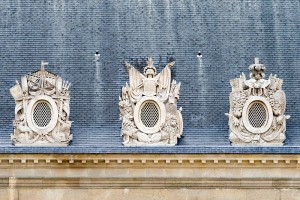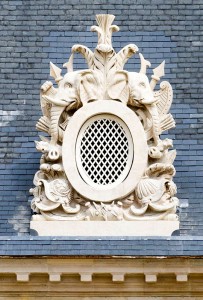
Three dormer windows up against the roof, in the Cour d’Honneur of the Hôtel des Invalides © Paris, musée de l’Armée, dist. RMN-GP / Émilie Cambier
Sculptures with allegorical animals adorn the sixty dormer windows of the Cour d’Honneur. The three reproduced above feature dolphins and lions. The lion is undoubtedly the most represented.
The dormer window decorated with two elephant heads is associated with the motto “Omnes delenturab uno elephas” (Elephants crush all enemies), the second one: “Micat inter omnes Julium sidus” (The Star of the House of Julius keeps on shining). © Paris, musée de l’Armée, dist. RMN-GP / Émilie Cambier.
This dormer window features four animal figures and is associated with the motto: “Micat exitiale superbis” (His radiance is fatal to their superb). © Paris, musée de l’Armée, dist. RMN-GP / Émilie Cambier.
A belligerent cockerel stands on the top of the dormer window, clawing a lion’s skin. Feathers in the wind, he turns his head in the direction of a lion desperately trying to reach him with his claws out. This dormer window is associated with the motto: “Formido rapacis” (He is the terror of the Beasts). © Paris, musée de l’Armée, dist. RMN-GP / Émilie Cambier
Decors of the Hôtel des Invalides
In 1670, King Louis XIV took the decision to build the Hôtel des Invalides to take care of his invalid soldiers and those too old to fight. Many renowned or anonymous artists contributed to the decor of the building. As part of the exhibition Animals & Wars and following the restoration of the galleries, the facades and the roof of the main courtyard as well as the central pavilion of the northern facade, we propose that you observe the animals carved in stone and whose image can be associated, directly or symbolically, with war.
Pachyderms
In the Cour d’Honneur, two dormer windows are decorated with elephants carved in stone. One of the elephants refers unmistakably to one of the greatest warrior in Antiquity to whom King Louis XIV, the “Sun King” liked to compare himself. Is it Alexander the Great (356-323 B.C.) who defeated King Porus and his 200 war elephants at the Battle of the Hydaspes, known today as the Jhelum River in the Punjab Province of Pakistan? Is it an allusion to the Carthaginian general Hannibal Barca (247-c.183 B.C.) and to his 20 war elephants defeated by the Romans at the Battle of Zama in Tunisia in 202 B.C.? Or do they refer to Julius Caesar (100-44 B.C.) who defeated the war elephants of the Numidian King Juba I in 46 B.C. at the Battle of Thapsus in Tunisia, before using sixteen war elephants to terrify an army of Gauls? Julius Caesar chose the elephant as his emblem. Two hooks of mahout are placed over the elephants’ heads. It’s up to you to find them!
The Chained Animals
The chained eagle and lion appearing on this dormer window are symbolic representation of the defeated opponents of King Louis XIV who took part in the War of Devolution (1667-1668): the Spanish Empire, the Kingdom of England, the Dutch Republic and the Swedish Empire, and in the Dutch War (1672-1678) to which must be added the Holy Roman Empire, the Margraviate of Brandenburg and Denmark-Norway. These allegorical animals are represented squatting, as if crushed, and fixed with terror on the sun, King Louis XIV emblem. Their wide-open beaks and jaws seem to implore its clemency. The lion is on the coat of arms of Spain, with reference to the Kingdom of León, the Dutch Republic, Denmark-Norway and the Kingdom of England. The eagle adorns the coat of arms of the Holy Roman Empire and the Margraviate of Brandenburg. The sun with a human face is surrounded by the club of Hercules and a ram, both symbols of strength.
Cockadoodle doo!
The Gallic rooster appears on several dormer windows in Cour d’Honneur and on a mural painting in the Salle de l’Europe, one of the four refectories of the Hotel. It is also present in the symbology of Louis XIV. Since ancient times, this bird has been associated with the sun and the dawn that dispels the darkness. It accompanies several divinities like Mercury. Ancient authors report that the sunrise and sunset of the planet associated with this god happen at the same time and in the same place as the sun. Due to its impetuous nature and combative character, the Gallic rooster is also the attribute of the gods Helios, Apollo, Minerva and Mars.
In Ancient Rome, the Gallic rooster was associated with the Gauls, because in Latin the word “gallus” designates both the Gauls and the rooster. In De Bello Gallico, Julius Caesar compared the courage of the Gauls with that of the rooster. Between the thirteenth and fifteenth centuries, the English and the Italians who strongly opposed French hegemonic desires used the rooster to mock French arrogance and represented the bestiary of their respective coat of arms devouring the gallinaceous. In flagrant contradiction, the House Valois and later on the House of Bourbon adopted the Gallic rooster, relying on the ancient Greco-Roman qualities and virtues associated with the bird: victory, eloquence, vigilance and fertility.





Ajouter un commentaire